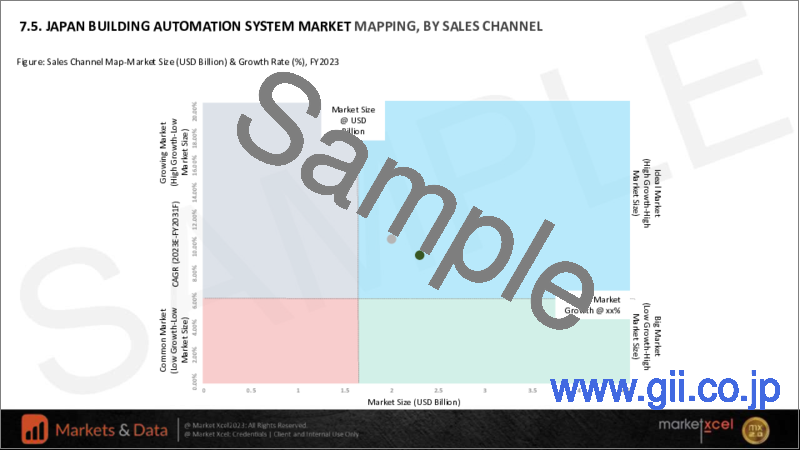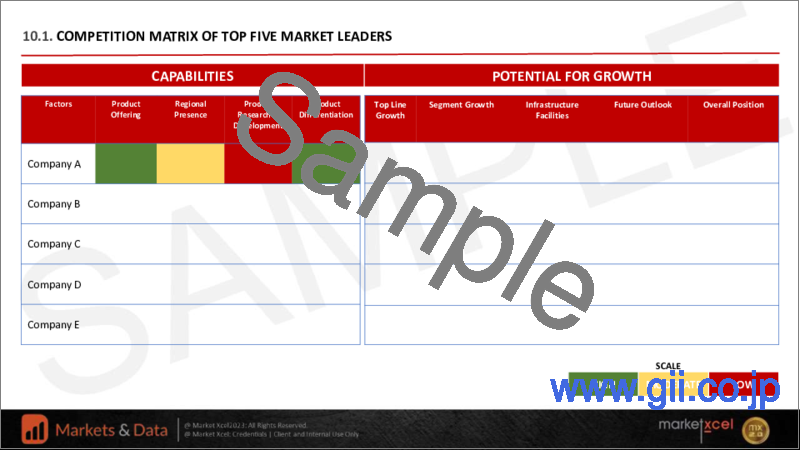|
|
市場調査レポート
商品コード
1355010
ビルディングオートメーションシステム(BAS)の日本市場の評価:コンポーネント別、用途別、通信技術別、エンドユーザー別、販売チャネル別、地域別、機会、予測(2017年度~2031年度)Japan Building Automation System Market Assessment, By Component, By Application, By Communication Technology, By End-user, By Sales Channel, By Region, Opportunities and Forecast, FY2017-FY2031 |
||||||
カスタマイズ可能
|
|||||||
| ビルディングオートメーションシステム(BAS)の日本市場の評価:コンポーネント別、用途別、通信技術別、エンドユーザー別、販売チャネル別、地域別、機会、予測(2017年度~2031年度) |
|
出版日: 2023年10月02日
発行: Market Xcel - Markets and Data
ページ情報: 英文 118 Pages
納期: 3~5営業日
|
- 全表示
- 概要
- 図表
- 目次
日本のビルディングオートメーションシステム(BAS)の市場規模は、2023年度に44億2,000万米ドル、2031年度に76億米ドルに達し、2024年度~2031年度の予測期間にCAGRで7.02%の成長が予測されています。日本において、BAS産業はエネルギー効率の高い構造物に対する需要の増加と、スマートホームやスマートビルディングの普及により、大幅な成長を示しています。省エネ法や建築基準法のような政府の取り組みや規制措置が、市場に大きな影響を与えています。政府は、建物のエネルギー消費を抑制し二酸化炭素排出を削減するため、エネルギー効率の高い技術の採用を積極的に推進しています。
さらに、スマートホームやスマートビルディングの動向の高まりが、先進のBASソリューションの需要を促進しています。これらのスマート構造物には、照明、HVAC、セキュリティ、その他のシステムの自動制御を促進するさまざまなセンサーやデバイスが組み込まれています。こうした技術を採用する住宅所有者やビル所有者が増えるにつれ、市場は大きく拡大する見込みです。日本におけるBAS市場の成長のもう1つの要因は、室内空気質と居住者の快適性の強化への注目の高まりです。先進のBASシステムは、温度、湿度、CO2レベルなどの室内空気質パラメーターをモニタリングおよび管理し、快適で健康的な室内環境を確保することができます。
スマートビルディング技術に対する需要の高まり
市場は、スマートビルディング技術に対する需要の高まりにより成長を示しています。この技術は、性能の最適化、エネルギー消費の削減、居住者の快適性の向上を目指しています。BASシステムは、エネルギー効率、居住者の快適性、IoTデバイスなどの要因によって集中制御とモニタリングを提供し、スマートビルディング技術の能力を向上させます。これらの技術は、エネルギー効率の強化にとどまらず、ビルの安全性とセキュリティにも及んでいます。ビルディングオートメーションシステム(BAS)を入退室管理、ビデオ監視、その他のセキュリティシステムと統合することで、スマートビルディングソリューションは安全対策を最適化しています。
セキュリティ・安全性ソリューションに対する需要の高まり
市場は、商業施設や住宅空間の安全性への懸念、自然災害の増加、世界の健康危機により、セキュリティ・安全性ソリューションへの需要が急増しています。セキュリティ対策と緊急対応プロトコルを統合した、堅牢で信頼性の高いBASシステムの必要性が高まっています。先進のBASは、タッチレスアクセス制御、居住モニタリング、空気質管理に効果的に対処でき、BASを居住者と資産の安全を守る貴重なツールとし、この分野の市場成長を促進しています。
政府の計画
日本の政府は、2050年までにカーボンニュートラルを目指すことで、パリ協定の目標に沿うことを約束しています。さらに、2030年までに温室効果ガス排出量を2013年度比で46%削減する目標を掲げています。政府は、建築物が日本の総エネルギー消費の約30%を占めていることを認識し、建築部門におけるエネルギー効率と再生可能エネルギー源の採用を促進することが喫緊の課題であると認識しています。こうした課題に対処するため、日本政府は、建設産業におけるエネルギー効率を規定する主な法律である建築物省エネ法を改正しました。「改正法」と総称されるこれらの改正は、2023年~2025年に段階的に実施される予定です。この法改正は、建設・建築部門におけるエネルギー効率と持続可能性の強化に対する政府のコミットメントを強調するものであり、温室効果ガス排出の削減と環境に優しい未来の育成という野心的な目標に沿ったものです。
COVID-19の影響
パンデミックは市場にさまざまな影響を与えました。一方で、パンデミックはビルの所有者や管理者が居住者の安全性と快適性を向上させようとする中で、BASシステムを含むスマートビルディング技術の採用を加速させました。また、パンデミックは室内空気質と換気の重要性を浮き彫りにし、HVACシステムをモニタリングおよび制御できるBASシステムに対する需要の増加につながっています。しかし、パンデミックは建設活動の鈍化を招き、新規BASプロジェクトの実施を遅らせました。パンデミックによる経済的不安から、ビルの所有者や管理者は新しいビルディングオートメーション技術への投資を遅らせました。さらに、世界のサプライチェーンの混乱により、特定のBAS部品が不足し、一部のプロジェクトで遅延とコストの増加を招きました。
当レポートでは、日本のビルディングオートメーションシステム(BAS)市場について調査分析し、市場規模と予測、市場力学、主要企業の情勢と見通しなどを提供しています。
目次
第1章 調査手法
第2章 プロジェクトの範囲と定義
第3章 日本のビルディングオートメーションシステム(BAS)市場に対するCOVID-19の影響
第4章 エグゼクティブサマリー
第5章 顧客の声
- 最終消費者の人口統計
- 製品と市場のインテリジェンス
- ブランドの想起とロイヤルティ
- 購入決定において考慮される要素
- 購入目的
- 購入頻度
- 購入媒体
- セキュリティとデータプライバシーへの配慮
第6章 日本のビルディングオートメーションシステム(BAS)市場の見通し(2017年度~2031年度)
- 市場規模と予測
- 金額
- コンポーネント別
- ハードウェア
- ソフトウェア
- 用途別
- HVAC制御システム
- 照明制御システム
- 電子セキュリティ・安全性
- 建物エネルギー管理システム
- 通信技術別
- 有線
- 無線
- その他
- エンドユーザー別
- 商業
- 工業
- 住宅
- 販売チャネル別
- 直接
- チャネル
- 地域別
- 北部
- 中部
- 南部
- 市場シェア:企業別(2023年度)
第7章 市場マッピング(2023年度)
- コンポーネント別
- 用途別
- 通信技術別
- エンドユーザー別
- 販売チャネル別
- 地域別
第8章 マクロ環境と産業構造
- 需給分析
- 輸出入の分析
- バリューチェーン分析
- PESTEL分析
- ポーターのファイブフォース分析
第9章 市場力学
- 成長促進要因
- 成長抑制要因(課題、抑制要因)
第10章 主要企業情勢
- マーケットリーダー上位5社の競合マトリクス
- マーケットリーダー上位5社の市場収益の分析(2023年度)
- 合併と買収/合弁事業(該当する場合)
- SWOT分析(市場参入企業5社向け)
- 特許分析(該当する場合)
第11章 価格分析
第12章 ケーススタディ
第13章 主要企業の見通し
- Siemens Limited
- Schneider Electric
- Johnson Controls
- ABB Asea Brown Boveri Ltd
- Beckhoff Automation
- Azbil Corporation
- Crestron Electronics Japan Pvt Ltd
- Carrier Corporation
- Honeywell International Inc.
- Legrand Japan Private Limited
第14章 戦略的推奨事項
第15章 当社について、免責事項
List of Tables
- Table 1. Pricing Analysis of Products from Key Players
- Table 2. Competition Matrix of Top 5 Market Leaders
- Table 3. Mergers & Acquisitions/ Joint Ventures (If Applicable)
- Table 4. About Us - Regions and Countries Where We Have Executed Client Projects
List of Figures
- Figure 1. Japan Building Automation System Market, By Value, In USD Billion, FY2017-FY2031F
- Figure 2. Japan Building Automation System Market Share, By Component, In USD Billion, FY2017-FY2031F
- Figure 3. Japan Building Automation System Market Share, By Application, In USD Billion, FY2017-FY2031F
- Figure 4. Japan Building Automation System Market Share, By Communication Technology, In USD Billion, FY2017-FY2031F
- Figure 5. Japan Building Automation System Market Share, By End-user, In USD Billion, FY2017-FY2031F
- Figure 6. Japan Building Automation System Market Share, By Sales Channel, In USD Billion, FY2017-FY2031F
- Figure 7. Japan Building Automation System Market Share, By Region, In USD Billion, FY2017-FY2031F
- Figure 8. By Component Map-Market Size (USD Billion) & Growth Rate (%), FY2023
- Figure 9. By Application Map-Market Size (USD Billion) & Growth Rate (%), FY2023
- Figure 10. By Communication Technology Map-Market Size (USD Billion) & Growth Rate (%), FY2023
- Figure 11. By End-user Map-Market Size (USD Billion) & Growth Rate (%), FY2023
- Figure 12. By Sales Channel Map-Market Size (USD Billion) & Growth Rate (%), FY2023
- Figure 13. By Region Map-Market Size (USD Billion) & Growth Rate (%), FY2023
Japan building automation system market size was valued at USD 4.42 billion in FY2023, which is expected to reach USD 7.6 billion in FY2031, with a CAGR of 7.02% for the forecast period between FY2024 and FY2031, designed to oversee and regulate various aspects of a building, including lighting, security, and HVAC (Heating, Ventilation, and Air Conditioning) systems. In Japan, the BAS industry is experiencing substantial growth driven by the increasing demand for energy-efficient structures and the proliferation of smart homes and buildings. Government initiatives and regulatory measures like the Energy Conservation Law and the Building Standards Act predominantly influence Japan's BAS market. The government actively promotes the adoption of energy-efficient technologies to curb energy consumption and reduce carbon emissions in buildings.
Furthermore, the rising trend of smart homes and buildings fuels the demand for advanced BAS solutions. These smart structures incorporate a range of sensors and devices that facilitate automated control of lighting, HVAC, security, and other systems. As more homeowners and building proprietors embrace these technologies, the BAS market is poised for significant expansion. Another contributing factor to the BAS market's growth in Japan is the heightened focus on enhancing indoor air quality and occupant comfort. Advanced BAS systems can monitor and manage indoor air quality parameters, including temperature, humidity, and CO2 levels, ensuring a pleasant and healthy indoor environment.
Rising Demand for Smart Building Technologies
The Japan Building Automation System (BAS) market is experiencing growth due to the increasing demand for smart building technologies. The technologies aim to optimize performance, reduce energy consumption, and improve occupant comfort. BAS systems provide centralized control and monitoring, driven by factors like energy efficiency, occupant comfort, and IoT devices, advancing the capabilities of smart building technologies. These technologies extend beyond enhancing energy efficiency to encompass building safety and security. By integrating Building Automation Systems (BAS) with access control, video surveillance, and other security systems, smart building solutions are optimizing safety measures. For instance, the Savic-net G5 is a building management system, building upon Azbil's established expertise in elevating building environments. This system incorporates state-of-the-art IoT, AI, and big data technologies, reflecting Azbil's dedication to developing innovative solutions that harmonize energy efficiency, occupant comfort, and safety. With this new generation of building management, input from all stakeholders connected to the building is actively encouraged and incorporated, ensuring a comprehensive and holistic approach to building optimization.
Focus on Occupant Comfort
The emphasis on user comfort is a major trend influencing the Japanese building automation system industry. Property managers and owners are prioritizing occupant comfort to boost building occupants' productivity and well-being. By offering centralized control and oversight of building systems, including heating, cooling, and lighting, BAS systems play a crucial role in allowing its focus on the comfort of occupants. BAS systems can optimize the indoor environment by adjusting real-time temperature, humidity, and lighting levels based on occupancy and outdoor weather conditions.
Occupancy sensors and other smart building technologies can further enhance occupant comfort by enabling BAS systems to personalize the indoor environment for individual occupants. For example, Johnson Controls relies on the Metasys Building Automation System as the cornerstone of contemporary building energy management effectiveness. This sophisticated, top-tier technology integrates commercial HVAC, lighting, security, and safety systems, enabling seamless communication on a unified platform. This empowers you to access the necessary information to make more intelligent decisions, all while improving the comfort, safety, and productivity of building occupants.
Rising Demand for Security and Safety Solutions
The Japan building automation system (BAS) market is experiencing a surge in demand for security and safety solutions due to concerns about safety in commercial and residential spaces, the increasing incidence of natural disasters, and the global health crisis. The need for robust, reliable BAS systems integrating security measures and emergency response protocols is increasing. Advanced BAS can effectively address touchless access control, occupancy monitoring, and air quality management, making BAS a valuable tool for safeguarding occupants and assets driving the market growth in this area.
In July 2023, Honeywell revealed its partnership with JGC Holdings Corporation, a prominent global engineering firm headquartered in Yokohama, Japan. In this collaboration, Honeywell will supply essential process control and safety instrumented systems for JGC's innovative green ammonia production facility. This initiative, backed by government funding, is a pioneering pilot project designed to establish an Integrated Control System for the green ammonia chemical plant. Its ultimate objective is positioning green ammonia as a substantial and dependable clean fuel source, aligned with the plant owners' Net Zero aspirations.
Government Schemes
The Japanese government promises to align with the goals of the Paris Agreement by aiming for carbon neutrality by 2050. Furthermore, the target has been set for reducing greenhouse gas emissions by 46% by 2030 compared to levels from the fiscal year 2013. Recognizing that buildings are responsible for approximately 30% of Japan's total energy consumption, the government has identified the pressing need to promote energy efficiency and the adoption of renewable energy sources in the building sector. To address these challenges, the Japanese government has amended the Building Energy Efficiency Act, the primary legislation governing energy efficiency in the construction industry. These amendments, collectively known as the "Amended Act," are set to be implemented gradually between 2023 and 2025. This legislative update underscores the government's commitment to enhancing energy efficiency and sustainability in the construction and building sectors, aligning with its ambitious targets for reducing greenhouse gas emissions and fostering an eco-friendly future.
Impact of COVID-19
The pandemic had a mixed impact on the Japan building automation system market. On the one hand, the pandemic has accelerated the adoption of smart building technologies, including BAS systems, as building owners and managers seek to improve occupant safety and comfort. Also, the pandemic has highlighted the importance of indoor air quality and ventilation, leading to increased demand for BAS systems that can monitor and control HVAC systems. However, the pandemic led to a slowdown in construction activity and delayed the implementation of new BAS projects. The economic uncertainty caused by the pandemic led building owners and managers to delay investments in new building automation technologies. Additionally, disruptions in global supply chains resulted in shortages of certain BAS components, causing delays and increased costs for some projects.
Key Players Landscape and Outlook
The forecast for the Japan BAS market is promising, and future years should see significant expansion. The market is expected to increase due to the rising use of smart building technology, the emphasis on occupant satisfaction, and government calls for higher energy efficiency. In addition, BAS providers should benefit from incorporating building automation systems alongside structural components like lighting and security. However, the market will probably encounter difficulties, such as COVID-19's effects on construction activity and supply chain interruptions. BAS providers must keep innovating and creating new technologies to address the changing demands of building managers and owners to remain competitive in the market.
For instance, in November 2022, PC-based building automation played a key role in creating a digital twin for Building H in Wuhan. From the start, Building H focused on green design principles. Beckhoff's technology seamlessly integrated all building equipment into a system developed by Dongfeng Design Institute. Building H has a digital twin for self-diagnosis, analysis, and autonomous decision-making. It's an 82,000-square-meter landmark in Wuhan with eco-friendly features like rooftop solar power and rainwater recycling, controlled by Beckhoff's system for reliable operation.
In February 2023, Toshiba Carrier Corporation disclosed its plans to release an improved energy-efficient wired remote control (RBC-AMSU52) for commercial air conditioning systems in April 2023. TCC operates within Carrier Global Corporation, a world leader in providing solutions for safe, sustainable, intelligent building environments and cold chain management. The updated product boasts enhanced functionality and user-friendliness, offering efficiency benefits for administration and maintenance tasks. Users can conveniently operate the equipment and access/share product information via a smartphone.
Table of Contents
1. Research Methodology
2. Project Scope & Definitions
3. Impact of COVID-19 on Japan Building Automation System Market
4. Executive Summary
5. Voice of Customer
- 5.1. Demographics of the End Consumer
- 5.2. Product and Market Intelligence
- 5.3. Brand Recall and Loyalty
- 5.4. Factors Considered in Purchase Decision
- 5.4.1. Quality
- 5.4.2. Pricing/Overall Expenses
- 5.4.3. Energy Efficiency
- 5.4.4. Reliability
- 5.4.5. After Sales Support
- 5.4.6. Technical Specifications and Features
- 5.4.7. Scalability and Integration
- 5.4.8. Reviews and Recommendations
- 5.5. Purpose of Purchase
- 5.6. Frequency of Purchase
- 5.7. Medium of Purchase
- 5.8. Consideration of Security and Data Privacy
6. Japan Building Automation System Market Outlook, FY2017-FY2031F
- 6.1. Market Size & Forecast
- 6.1.1. By Value
- 6.2. By Component
- 6.2.1. Hardware
- 6.2.2. Software
- 6.3. By Application
- 6.3.1. HVAC Control Systems
- 6.3.2. Lighting Control Systems
- 6.3.3. Electronic Security & Safety
- 6.3.4. Building Energy Management System
- 6.4. By Communication Technology
- 6.4.1. Wired
- 6.4.2. Wireless
- 6.4.3. Others
- 6.5. By End-user
- 6.5.1. Commercial
- 6.5.2. Industrial
- 6.5.3. Residential
- 6.6. By Sales Channel
- 6.6.1. Direct
- 6.6.2. Channel
- 6.7. By Region
- 6.7.1. North
- 6.7.2. Central
- 6.7.3. South
- 6.8. By Company Market Share (%), FY2023
7. Market Mapping, FY2023
- 7.1. By Component
- 7.2. By Application
- 7.3. By Communication Technology
- 7.4. By End-user
- 7.5. By Sales Channel
- 7.6. By Region
8. Macro Environment and Industry Structure
- 8.1. Supply Demand Analysis
- 8.2. Import Export Analysis
- 8.3. Value Chain Analysis
- 8.4. PESTEL Analysis
- 8.4.1. Political Factors
- 8.4.2. Economic System
- 8.4.3. Social Implications
- 8.4.4. Technological Advancements
- 8.4.5. Environmental Impacts
- 8.4.6. Legal Compliances and Regulatory Policies (Statutory Bodies Included)
- 8.5. Porter's Five Forces Analysis
- 8.5.1. Supplier Power
- 8.5.2. Buyer Power
- 8.5.3. Substitution Threat
- 8.5.4. Threat from New Entrant
- 8.5.5. Competitive Rivalry
9. Market Dynamics
- 9.1. Growth Drivers
- 9.2. Growth Inhibitors (Challenges and Restraints)
10. Key Players Landscape
- 10.1. Competition Matrix of Top Five Market Leaders
- 10.2. Market Revenue Analysis of Top Five Market Leaders (in %, FY2023)
- 10.3. Mergers and Acquisitions/Joint Ventures (If Applicable)
- 10.4. SWOT Analysis (For Five Market Players)
- 10.5. Patent Analysis (If Applicable)
11. Pricing Analysis
12. Case Studies
13. Key Players Outlook
- 13.1. Siemens Limited
- 13.1.1. Company Details
- 13.1.2. Key Management Personnel
- 13.1.3. Products & Services
- 13.1.4. Financials (As reported)
- 13.1.5. Key Market Focus & Geographical Presence
- 13.1.6. Recent Developments
- 13.2. Schneider Electric
- 13.3. Johnson Controls
- 13.4. ABB Asea Brown Boveri Ltd
- 13.5. Beckhoff Automation
- 13.6. Azbil Corporation
- 13.7. Crestron Electronics Japan Pvt Ltd
- 13.8. Carrier Corporation
- 13.9. Honeywell International Inc.
- 13.10. Legrand Japan Private Limited
Companies mentioned above DO NOT hold any order as per market share and can be changed as per information available during research work





